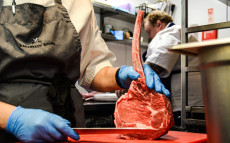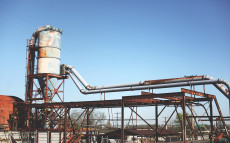- pathfindersAI
- Job Profile
Meat, Poultry, and Fish Cutters and Trimmers
Summary
Meat, Poultry, and Fish Cutters and Trimmers: A Detailed Job Description
What They Do
Meat, poultry, and fish cutters and trimmers are crucial to the food supply chain, specializing in preparing and portioning various types of proteins for consumer purchase. These professionals work in diverse settings, from large processing plants and supermarkets to smaller butcher shops and specialty gourmet stores. Their primary focus revolves around ensuring that meats, poultry, and fish meet rigorous quality and safety standards, preparing them for retail sale or further processing. They play an indispensable role in transforming raw products into ready-to-cook or ready-to-eat items, contributing significantly to the culinary industry and consumer health.
Job Responsibilities
The responsibilities of a meat, poultry, and fish cutter/trimmer are multifaceted. They entail weighing, preparing, and cutting various meats to exact specifications, ensuring safe and hygienic practices throughout the process. Additionally, these professionals are often responsible for deboning, trimming excess fat, and grinding meat to meet customer or institutional requirements. They meticulously inspect the product for any defects or concerns, maintaining strict adherence to food safety regulations and quality assurance standards. Furthermore, they must keep their work area clean and sanitized, adhering to rigorous hygiene protocols to prevent contamination. In some cases, they may also handle the wrapping, labeling, and displaying of products for sale, providing customer service and expertise on cooking methods and storage tips.
Essential Skills
Success as a meat, poultry, and fish cutter/trimmer hinges on a combination of technical expertise, physical dexterity, and interpersonal skills. Precision is paramount, as the job requires accurate cuts and measurements to maximize product utilization and minimize waste. Physical stamina and strength are also critical, given the demands of handling heavy cuts of meat and standing for extended periods. Additionally, a keen eye for detail is essential for identifying the quality of products and adhering to safety standards. Equally important are strong communication and customer service skills, particularly for those working in direct-to-consumer environments. Advanced positions may also necessitate some level of managerial competence, tasked with overseeing a team and ensuring all protocols are followed.
Educational Pathways
The educational requirements for meat, poultry, and fish cutters and trimmers can vary based on the complexity of the work environment and the specific employer's needs. While a high school diploma or equivalent is typically adequate for entry-level positions, specialized roles may benefit from further education or training. Vocational schools and community colleges often offer relevant courses in meat processing, food safety, and culinary arts. Apprenticeships and on-the-job training programs provide invaluable hands-on experience under the guidance of seasoned professionals. Certification programs through organizations such as the American Meat Science Association or the National Institute of Meatpacking offer additional credentials that can enhance career prospects and potentially lead to supervisory roles.
Career Prospects
The field of meat, poultry, and fish cutting and trimming presents promising career opportunities, bolstered by a consistent demand for skilled workers in the food production and retail sectors. As consumer preferences evolve towards more specialized and gourmet products, there is a growing niche for highly trained cutters with expertise in organic, grass-fed, and artisanal techniques. This role also serves as a stepping stone to more advanced positions within the food industry, including roles in quality control, procurement, and meat inspection. With sufficient experience and expertise, individuals may even venture into entrepreneurship, opening their own butcher shops or specialty meat stores. The Bureau of Labor Statistics projects a steady employment growth rate in this sector, underscoring the continual need for these fundamental skills.
Conclusion
In conclusion, meat, poultry, and fish cutters and trimmers occupy a vital role within the food industry, ensuring that high-quality protein products reach consumers in a safe and appealing form. This profession demands a blend of technical acumen, physical capability, and soft skills, coupled with a dedication to maintaining high standards of cleanliness and safety. Educational pathways provide various entry points into the field, from vocational training to hands-on apprenticeships, equipping aspiring cutters with the competencies required to excel. With a range of career prospects and advancement opportunities, this career not only sustains but also thrives amid the ever-changing culinary landscape. Thus, choosing a career as a meat, poultry, and fish cutter or trimmer can prove to be both a fulfilling and sustainable professional journey.
Video
Compensation
| State | Median Salary | Median Hourly | Positions |
|---|---|---|---|
| AL | 30,010 | 14.43 | 10,080 |
| AK | 35,520 | 17.08 | 1,820 |
| AZ | 47,870 | 23.01 | 650 |
| AR | 35,350 | 17.00 | 9,750 |
| CA | 36,000 | 17.31 | 6,750 |
| CT | 32,510 | 15.63 | 380 |
| DE | 32,950 | 15.84 | 5,530 |
| DC | 58,140 | 27.95 | 50 |
| FL | 37,340 | 17.95 | 2,380 |
| GA | 35,880 | 17.25 | 11,290 |
| HI | 39,390 | 18.94 | 750 |
| ID | 28,600 | 13.75 | 110 |
| IL | 37,600 | 18.08 | 3,230 |
| IN | 41,240 | 19.83 | 2,640 |
| IA | 39,560 | 19.02 | 3,640 |
| KS | 43,790 | 21.05 | 4,820 |
| KY | 43,660 | 20.99 | 1,040 |
| LA | 28,440 | 13.68 | 2,450 |
| ME | 37,910 | 18.23 | 830 |
| MD | 27,560 | 13.25 | 910 |
| MA | 32,960 | 15.85 | 2,080 |
| MI | 41,620 | 20.01 | 960 |
| MN | 37,990 | 18.26 | 3,750 |
| MS | 33,540 | 16.12 | 6,860 |
| MO | 37,790 | 18.17 | 4,080 |
| MT | 33,890 | 16.29 | 40 |
| NE | 44,160 | 21.23 | 6,620 |
| NV | 31,200 | 15.00 | 220 |
| NJ | 38,110 | 18.32 | 1,470 |
| NM | 31,200 | 15.00 | 170 |
| NY | 35,680 | 17.15 | 2,160 |
| NC | 36,630 | 17.61 | 5,960 |
| ND | 36,800 | 17.69 | 110 |
| OH | 36,620 | 17.60 | 3,310 |
| OK | 33,360 | 16.04 | 1,110 |
| OR | 34,340 | 16.51 | 780 |
| PA | 39,260 | 18.87 | 1,430 |
| RI | 36,370 | 17.48 | 240 |
| SC | 31,950 | 15.36 | 3,390 |
| SD | 40,670 | 19.55 | 1,930 |
| TN | 34,820 | 16.74 | 2,460 |
| TX | 35,530 | 17.08 | 6,530 |
| UT | 36,120 | 17.36 | 970 |
| VA | 34,420 | 16.55 | 2,280 |
| WA | 37,140 | 17.86 | 4,040 |
| WV | 31,290 | 15.05 | 240 |
| WI | 38,300 | 18.41 | 1,250 |
| WY | 34,890 | 16.77 | 130 |
Similar Occupations
In this area you will find other occupations that are close to the one you were viewing in tasks, knowledge and work environment. If the primary job profile you are viewing isn't quite to your liking, take a look around and see what else is available.
Basic and Premium Accounts have more alternative occupations available than the Free account.

Butchers and Meat Cutters - 51-3021.00
Butchers and Meat Cutters are professionals responsible for preparing meat for consumer use by slaughtering, deboning, trimming, and cutting into various types of cuts, ensuring optimal quality and portion control. They also handle the storage, packaging, and display of meat products, adhering to sanitary and safety standards.
-
$37,650/yr
Median Pay -
136,330
Number of Jobs

Cutting and Slicing Machine Setters, Operators, and Tenders - 51-9032.00
Cutting and Slicing Machine Setters, Operators, and Tenders are responsible for configuring and managing machines that cut or slice various materials such as metal, wood, textiles, food, and more. They ensure precision and quality by monitoring the equipment, making adjustments as necessary, and performing routine maintenance to keep the machinery in optimal working condition.
-
$44,310/yr
Median Pay -
52,720
Number of Jobs